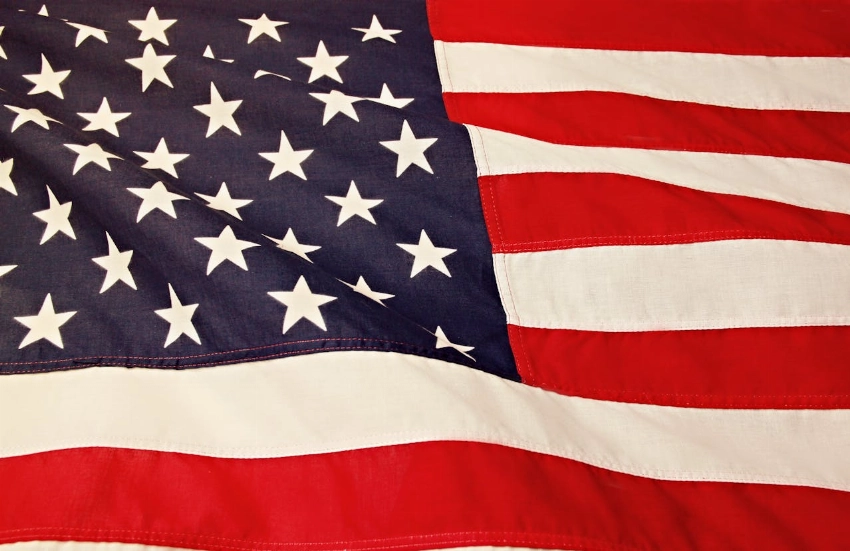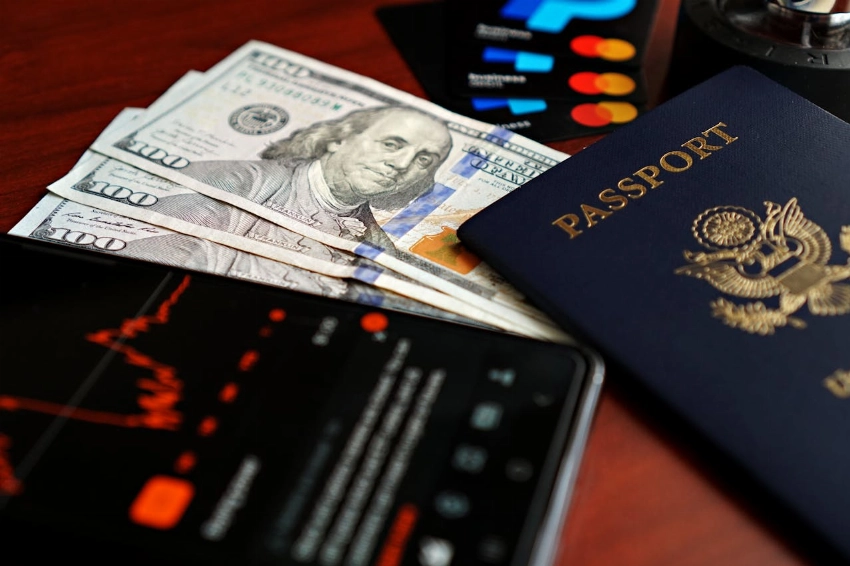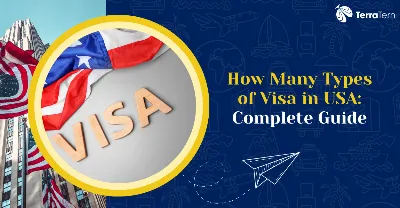Key Highlights
- Latest Facts & News on U.S. Visa Types (2025): Hook & Highlights
- Overview of U.S. Visa Categories
- Non Immigrant Visas – Temporary Stay in the U.S.
- Immigrant Visas – Permanent Residency (Green Card)
- Employment-Based Immigrant Visas (EB-1 to EB-5)
- How Many Types of Visa Category in USA for Study?
- How Many Types of Working Visa in USA for Indian Applicants?
- Visa Application Process & Tips
- Conclusion
The complex aspects of U.S. immigration may become overwhelming to navigate due to the how many types of visa in USA. Whether it is your dream to feel the amazing culture of the country, to pursue the top-notch learning, or to actively participate in the prospering U.S. economy, the first thing you need to realise is what kind of visa you need based on your expectations. Through this guide to 2025, we will clear the mist that remains in the picture of how many types of visa in USA, offer you a road map to your various American dreams and how many types of visas are there in USA.
Latest Facts & News on U.S. Visa Types (2025): Hook & Highlights

-
The U.S has more than 185 visa classes, which are divided into immigrant and nonimmigrant groups.
-
New changes to the policy have simplified the application process for an Indian visa.
-
F-1 student visas are most popular among overseas students, counting more than 350,000 visas issued last year.
-
The cap on H-1B visas for 2025 is 85,000, with STEM applicants being the largest in number.
-
Some visa renewals may be made in the U.S. in new pilot programs that do not require consular processing.
-
The Diversity Visa Lottery is still giving the 55,000 green cards each year.
-
Indian nationals are in the leading list of recipients of the H-1B and L-1 work visas.
-
The U.S. has broadened the eligible O-1 visas to digital content creators.
-
New modifications to the J-1 Exchange Visitor Program have resulted in the multiplication of opportunities in research and academia.
-
Immigrant visa processing times are better and family-based categories are the fastest to be approved in five years.
Interested in knowing how many types of visa in USA is right to accomplish your ambitions? This introductory guide can lead you in full swing to all the categories, eligibility, and the latest news! Let’s know how many types of visa in USA!
Also Read: US Tourist Visa Cost for Indian: Latest Guide & Fees
Overview of U.S. Visa Categories
The best way to know how many types of visa in USA is to understand the basic difference between the two broad categories, namely, the nonimmigrant and immigrant visas. It is the basis of all the specific visa types, which in turn determine the character and length of your visit to America.
Nonimmigrant Visas are intended to be used by foreign nationals who are planning to visit the U.S. temporarily with a particular goal, including tourism, business, education or even temporary employment. These visas are limited by time, and usually they demand the user of the visa holder to show that they intend to return to their homeland.
Immigrant Visas, however, are issued to people who want to obtain the right to permanent residence in the United States and, finally, acquire a Green Card. Such visas provide an opportunity for permanent residence and future citizenship. For clear understanding and success in Visa accomplishment we need to understand how many types of visas are there in USA.
To start with, these two vast categories help to understand which of them applies to your concrete travelling or moving to a new location. All the categories are further split into many visa types, each having its eligibility requirements as well as the procedure of acquiring the particular visa.Let’s further know about how many types of visa in USA!
Non Immigrant Visas – Temporary Stay in the U.S.

The United States affords a great variety of nonimmigrant visas, adapting to different temporary purposes of stay. No matter what the reason is that you are coming to the U.S. and whether you are coming on vacation, to study, to work, or to do some sort of a cultural exchange, most likely there exists a particular type of nonimmigrant visa that would be right to suit your requirements. The rest of the section outlines the most popular types of nonimmigrant visas, illuminating how many types of visa in USA that foreigners can acquire when they want to visit the country temporarily. Let’s learn more about how many types of visas are there in USA!
-
B-1, B-2 Visitor Visa
When the question is asked that how many types of visa in USA, one should know that the other nonimmigrant visa that is issued most often is the B-1 and B-2 visa which allows people to come to U.S. to undertake various short-term activities. The B-1 visa allows business-related travel only whereas B 2 is inclusive of tourism, leisure, and medical treatment. Sometimes they are merged into one type of visa B1/B2.
-
B-1 Visa (Business Visitor): This visa is assigned to the person going to the U.S. to conduct a legitimate business that is not associated with gainful employment. Some examples are attending at conferences, negotiating contracts, consulting with business associates or even short-term training.
-
B-2 Visa (Tourist Visa): This type of visa is intended to visit the U.S. temporarily, such as vacation or sightseeing, visiting friends and family and to seek medical treatment. It does not allow employment.
-
Student Visas (F, M, J)
In a student visa, there are certain types of visas, which are given to students who would like to study either academically or vocationally in the U.S, or some students who are on some sort of exchange programs. The needs of foreign students are essential when they are not aware of the quantity how many types of visa in USA.
-
F-1 Visa (Academic Student): The most often granted student visa, the F-1 visa is meant to be taken by people who are planning to get full-time academic education at a certified United States college, university, seminary, conservatory, academic high school or elementary school or other academic establishment.
-
M-1 Visa (Vocational Student): Is a visa that is issued to those students taking non-academic or job training school courses, including but not limited to technical schools, cooking schools, or flight schools.
-
J-1 Visa (Exchange Visitor): The J-1 visa is used by people who are undertaking an exchange visitor program approved to enable their cultural exchange. This comprises the students, scholars, researchers, au pairs, interns, and specialists.
-
Work Visas (H, L, O, P, Q, R)
When the question is asked how many types of visa in USA we should know that, the U.S. offers various temporary work visa categories for foreign nationals seeking employment in the country. These visas typically require a U.S. employer to sponsor the applicant and are designed for specific types of occupations or skills. When considering how many types of working visas in USA for Indian applicants exist, these categories are particularly relevant.
-
H-1B Visa (Speciality Occupation)
For individuals working in speciality occupations that require a bachelor's degree or higher in a specific field, such as IT professionals, engineers, and healthcare workers. This visa is highly sought after and subject to an annual cap.
-
L-1 Visa (Intra-company Transferee)
For employees of international companies who are being temporarily transferred to a parent, branch, affiliate, or subsidiary of the same company in the U.S., this includes L-1A for managers/executives and L-1B for those with specialised knowledge.
-
O-1 Visa (Extraordinary Ability)
For individuals with extraordinary ability in the sciences, arts, education, business, or athletics, or who have a demonstrated record of extraordinary achievement in the motion picture or television industry and have been recognised nationally or internationally for those achievements.
-
P Visas (Athletes, Artists, and Entertainers)
For internationally recognised athletes, artists, or entertainers performing or competing in the U.S.
-
P-1 Visa: For internationally recognised athletes (individually or as part of a team) or members of an internationally recognised entertainment group.
-
P-2 Visa: For artists or entertainers performing under a reciprocal exchange program between organisations in the U.S. and other countries.
-
P-3 Visa: For artists or entertainers performing, teaching, or coaching under a culturally unique program.
-
Q-1 Visa (International Cultural Exchange Visitor)
For participants in an international cultural exchange program designed to provide practical training, employment, and to share the history, culture, and traditions of their home country.
-
R-1 Visa (Religious Worker)
For individuals who wish to enter the U.S. temporarily to work in a religious vocation or occupation.
Immigrant Visas – Permanent Residency (Green Card)

The big question is that how many types of visa in USA, with that you also know that the individual who is hoping that the U.S. will forever remain his/her place of residence, immigrant visas offer the road to a Green Card. These visas are divided by the family relationship, employment or the diversity lottery, hence providing different ways to become permanent residents.
Immigrant Visas Family-Based
The foundation of the U.S. immigration policy has been family reunification, and many of the immigrant visas are given to relatives of U.S. citizens or permanent residents who have lawful permanent residence status (Green Card holders).
-
Immediate Relatives of U.S. Citizens: There is no limitation regarding the number of these visas, and therefore, there is no queue after the petition is granted.
-
IR-1/CR-1: The married couples of U.S citizens.
-
IR-2/CR-2: Unmarried children under the age of 21 of U.S citizens.
-
IR-3/IH-3: Orphans who are adopted overseas by citizens of the U.S.
-
IR-4/IH-4: Orphans wanting to be adopted in the U.S by U.S citizens.
-
IR-5: Parents (USA citizens) (in case the U.S. citizen is older than 21).
-
Family Preference: The category of the visas is limited annually by number andis usually accompanied by delay, which is shown in the monthly Visa Bulletin.
-
F1: Unmarried sons, daughters of the U.S citizens, and the minor children.
-
F2A: Husband and wife and children under 21 years unmarried children of Lawful Permanent Residents.
-
F2B: Unmarried sons and daughters (21 years old or more), with Lawful Permanent Residents as parents.
-
F3: Sons and daughters of the U.S. citizens who are married, and their spouses and children who are under the age of 21.
-
F4: Siblings (brothers and sisters) of U.S citizens, and the spouses or children (person under the age of 21 years), of such U.S citizen.
Also Read: US Immigration: Everything You Should Know Is Here
Employment-Based Immigrant Visas (EB-1 to EB-5)

These are the visas to persons who bring their skill, education or investment to enhance the economy of the U.S. They are also limited to the numeric quota annually.
-
EB-1 (Priority Workers): EB-1 Priority workers include the gifted with extraordinary abilities, exceptional professors/researchers and international executives or managers.
-
EB-2 (Professionals Holding Advanced Degrees or Persons of Exceptional Ability): To professionals with advanced degrees or with exceptional ability in the sciences, arts or business.
-
EB-3 (Skilled Workers, Professionals, and other workers): For skilled workers (they should have at least 2 years of training or experience), professionals (a bachelor's degree is required), and other workers (perform unskilled jobs that require less than 2 years of training or experience).
-
EB-4 (Certain Special Immigrants): This category comprises religious workers, certain broadcasters, Iraqi and Afghan translator, and some other special immigrants.
-
EB-5 (Immigrant Investors): To foreign investors who meet the specified investment and make a qualifying investment in a U.S. commercial enterprise with the capability of creating or preserving at least 10 full-time jobs for U.S workers.
Diversity Visa Lottery
The Green Card Lottery, an immigrant visa program, otherwise referred to as the Diversity Immigrant Visa Program, offers up to 55,000 immigrant visas each year. These visas are selected randomly as a lottery on candidates who fit the easy yet stringent criteria of qualifiers living in nations with low immigration rates to the United States historically. Let’s further know more about how many types of visa in USA!
How Many Types of Visa Category in USA for Study?
How many types of visa in USA may be confusing to aspiring international students. It is important to realise that the number of categories is rather large, yet they are strictly segmented according to the types of educational programs and opportunities for exchange. There are F, M, and J visas as the main types of student visas, and each of them has its own requirements and rules. Let’s know more about the how many types of visa in USA!
F-1, F-2, F-3 Visas
To understand better we need to learn about how many types of visa category in USA for study. The most common F visa category available in the U.S. is the one that is used in academic activities.
-
F-1 Visa (Academic Student): This Visa applies to full-time students taking academic courses at accredited colleges, universities, high schools, private schools, seminaries, conservatories, or other academic institutes, including language training programs. An F-1 visa holder is usually allowed to remain in the United States until their academic course is complete, with an additional time of Optional Practical Training (OPT) in case of one.
-
F-2 Visa (Dependents of F F-1): F-2 Visa is issued to spouse and unmarried minor children (under 21 years of age) of an F-1 visa holder. The F-2 dependents are usually not allowed to work in the U.S, minor kids can study in the publicly funded elementary and secondary institutions.
-
F-3 Visa (Commuter Student Visa Canada and Mexico): This represents a narrow option and is offered to Canadian or Mexican citizens who live close to the U.S. border and travel into the U.S. to attend an academic institution within the U.S.
M-1, M-2, M-3 Visas
The M-visa category is exclusively developed for vocational/non-academic studies.
-
M-1 Visa (Vocational Student): M-1 Visa is granted to students studying a vocational or other non-academic and recognised course that includes technical training, cooking school or flight school. The M-1 students are usually not able to switch their field of study, and there are fewer employment opportunities compared with the F-1 students.
-
M-2 Visa (Dependents of M-1): The M-2 visa is offered to dependent spouses and unmarried minor dependents (under 21 years of age) of the M-1 visa holder. M-2 dependents cannot get facilities to work in the U.S.
-
M-3 Visa (Commuter Vocational Student from Canada/Mexico): This is identical to the F-3 except that the holder is a Canadian or Mexican citizen who lives near the border of the United States and travels to a vocational school in the United States.
J-1, J-2 Visas
For visa success we need to know about how many types of visa category in USA for study. The J-visa type is for those who take part in exchange visitor programs, which also may include an educational aspect.
-
J-1 Visa (Exchange Visitor): This is a visa accorded to persons registered to take part in the exchange visitor programs (work and study-based). This is a rather general group of participants, which comprises students (college/university, secondary school), scholars, interns, teachers, professors, research scholars, specialists, and, finally, au pairs. The J-1 program is aimed at cultural exchange.
-
J-2 Visa (Dependents of J-1): This type of visa is designated for the dependents (spouses and unmarried minor children, under the age of 21 years old) of the J-1 visa recipient. J-2 dependents can also seek permission to work, provided this is not required to maintain (supplementing) the J-1 principal.
To illustrate the differences and key aspects of how many types of visa in USA, consider the following table:
|
Visa Type |
Purpose |
Eligibility Highlights |
Work Authorization |
Duration |
|
F-1 |
Academic Study |
Acceptance to an SEVP-approved academic institution, proof of funds, and intent to return. |
Limited on-campus, CPT, OPT |
Program duration + OPT |
|
M-1 |
Vocational Study |
Acceptance to an SEVP-approved vocational institution, proof of funds, and intent to return. |
Limited, typically after program completion. |
Program duration + 1 month for every 4 months of study (max 1 year) |
|
J-1 |
Exchange Program |
Participation in an approved exchange program, sponsored. |
Varies by program, may require specific authorisation. |
Program-specific, generally up to 7 years. |
How Many Types of Working Visa in USA for Indian Applicants?
Now the main question is how many types of working visa in USA for Indians work in the United States, a system of different work visas must be known by Indian nationals keen on working in the US. The U.S. presents various work visas to work temporarily in different skills, sectors, and job-related cases. Though the H-1B visa has become the most popular one, it is important to introduce different options and find the most appropriate one to meet professional demands. The next part goes into the details of the use of how many types of visa in USA by Indian candidates. Let’s learn more about how many types of working visa in USA for Indians!
-
H-1B, H-2A, H-2B, H-3, H-4 Visas
The category of H-visa also constitutes a major channel of temporary employees in the U.S, which covers different types of venues of job opportunities.
-
H-1B Visa (Speciality Occupation): H-1B Nonimmigrant Visa is the most popular work visa that is offered to Indian professionals. It is to serve people in speciality occupations which demand a body of highly specialised knowledge, a theoretical application as well as practical application of such knowledge and a bachelor's or higher degree in that speciality. Such common areas are: IT, engineering, medicine and architecture. It mandates a U.S. employer to petition on behalf of applicants, and it has an annual limitation, which is often filled on a lottery basis.
-
H-2A Visa ( Temporary Agricultural Worker ): This is used to do agricultural work, which is temporary or on a seasonal basis. It can be used by citizens of some countries, and the employers have to prove that the U.S. workers are not sufficient to do the job.
-
H-2B Visa (Temporary Non-Agricultural Worker): The H-2B visa is granted to non-agricultural workers who are seasonal or temporary. Employers in the H-2A program, just like the H-2A, must establish a temporary need for employees and the unavailability of U.S. employees. There is also a cap on this visa.
-
H-3 Visa (Trainee or Special Education Exchange Visitor): Such a visa enables a foreign national to train in a different field that is not accessible in their home state. This visa is not applicable in graduate medical education. It includes the involvement in a special education exchange visitor program as well.
-
H-4 Visa (Dependants of H Visa workers): It is issued to the spouse and unmarried minor children (under 21 years old) of H-1B, H-2A, H-2B or H-3 visa holders. In some situations, family members of H-1B visa holders, the H-4 spouses, can apply to work.
-
L-1A, L-1B, L-2 Visas
L-visa is the category which promotes the intra-company transfer of employees of multinational corporations.
-
L-1A Visa (Intra-company Transferee Managers or Executives): The L-1A Visa is available to managers or executives who have lived at least one continuous year in a foreign organisation in the last 3 years and is being transferred to a United States office of the same employer in an executive or entrepreneurial position.
-
L-1B Visa (Intra-company Transferee for Specialized Knowledge): An intra-company transferee who has attained into specialized knowledge and who has worked in an organization that is qualified in another country continuously of not less than one year in the last three years and being moved to a U.S office at which he is to render services that necessitates the use of his specialized knowledge undergoes this visa.
-
L-2 Visa (Dependents of L-1): This visa is a spouse and children (below 21 years old) of the person holding L-1A or L-1B visas. Even spouses of L-2 may file a claim to work in L-2.
-
O, P, Q, R Visas
Understanding how many types of visa in USA and knowing that beyond the H and L categories, several other temporary work visas cater to specific talents, industries, and cultural exchanges.
-
O-1 Visa (Extraordinary Ability): As mentioned, this visa is for individuals with extraordinary ability in the sciences, arts, education, business, or athletics, or extraordinary achievement in the motion picture or television industry. This is a highly sought-after visa for top talent.
-
P Visas (Athletes, Artists, and Entertainers): This category includes P-1 (internationally recognized athletes/entertainment groups), P-2 (artists/entertainers in reciprocal exchange programs), and P-3 (artists/entertainers in culturally unique programs).
-
Q-1 Visa (International Cultural Exchange Visitor): This visa allows individuals to participate in international cultural exchange programs. It provides practical training, employment, and the opportunity to share their home country's culture, history, and traditions with the American public.
-
R-1 Visa (Religious Worker): This visa is for foreign nationals who wish to come to the U.S. temporarily to work in a religious vocation or occupation for a religious organization.
To provide a quick reference for common work visas for Indian applicants, consider the table below:
|
Visa Type |
Primary Purpose |
Common Indian Applicants |
Cap Subject? |
Work Authorization for Dependents |
|
H-1B |
Specialty Occupation |
IT Professionals, Engineers, Doctors |
Yes |
Yes (H-4 EAD for spouses in some cases) |
|
L-1A |
Intra-company Executive/Manager |
Senior Managers, Executives |
No |
Yes (L-2 spouses) |
|
L-1B |
Intra-company Specialized Knowledge |
Software Architects, Engineers with unique skills |
No |
Yes (L-2 spouses) |
|
O-1 |
Extraordinary Ability |
Scientists, Artists, Athletes, Entrepreneurs |
No |
No |
|
R-1 |
Religious Worker |
Priests, Nuns, Religious Teachers |
No |
No |
Visa Application Process & Tips

Applying for a U.S. visa can be a detailed process. Understanding how many types of visa in USA and understanding each step and preparing thoroughly can significantly increase your chances of success. While specific requirements vary by visa type, the general application process follows a similar outline.
1. Determine Your Visa Type
This is the most critical first step. Carefully research and select the visa category that best matches your purpose of travel to the U.S. The information in this guide provides a solid starting point.
2. Complete the DS-160 Form
The Online Nonimmigrant Visa Application (DS-160) is a mandatory electronic form for all nonimmigrant visa applicants. Ensure all information is accurate and complete. You will need to upload a digital photograph that meets specific U.S. visa photo requirements.
3. Pay the Visa Application Fee (MRV Fee)
The non-refundable visa application fee (Machine Readable Visa Fee) must be paid before scheduling your interview. The amount varies by visa category. Keep your payment receipt as it's required for scheduling.
4. Schedule Your Visa Interview
Once your DS-160 is submitted and the fee paid, you can schedule your visa interview at a U.S. Embassy or Consulate in your country of residence. Wait times can vary significantly, so plan accordingly.
5. Gather Required Documents
This is where meticulous preparation is key. The specific documents will depend on your visa type, but commonly include:
-
Valid passport (valid for at least six months beyond your intended period of stay)
-
DS-160 confirmation page
-
Visa fee payment receipt; one passport-sized photograph
-
Proof of financial means to cover your stay
-
Evidence of ties to your home country (e.g., property deeds, family responsibilities, job offer letters)
-
For student visas, the form I-20 (for F/M) or DS-2019 (for J), SEVIS I-901 fee payment receipt, academic transcripts,and acceptance letters.
-
For work visas the approved Form I-129 petition, employment offer letters, educational and professional qualifications.
-
For family-based immigrant visas, the approved Form I-130 petition, Affidavit of Support (Form I-864).
6. Attend Your Visa Interview
On the day of your interview, arrive on time with all your original documents. Be prepared to answer questions truthfully and concisely about your purpose of travel, your ties to your home country, and your plans in the U.S. Consular officers conduct security and eligibility checks and will determine if you qualify for the visa. Digital fingerprint scans are taken as part of the process.
7. Visa Processing and Collection
If your visa is approved, the consular officer will usually keep your passport to affix the visa. You will then be notified when and where to collect your passport with the visa.
Tips for a Smooth Application:
-
Be Honest and Accurate: Provide truthful and complete information on all forms and during your interview. Misrepresentation can lead to visa denial and future ineligibility.
-
Prepare Thoroughly: Gather all required documents well in advance. Organize them neatly for easy access during the interview.
-
Understand Your Purpose: Clearly articulate your reason for visiting the U.S. and how it aligns with the visa category you've chosen.
-
Demonstrate Ties to Home Country: Convince the consular officer that you have strong economic, social, and family ties to your home country that will compel you to return after your temporary stay (for nonimmigrant visas).
-
Practice Your Answers: While you shouldn't memorise a script, be comfortable discussing your application details and intentions.
-
Dress Professionally: Present yourself respectfully for the interview.
-
Be Patient and Polite: Consular officers process many applications daily. Remain calm and courteous throughout the process.
-
Check Embassy/Consulate Website: Always refer to the official website of the U.S. Embassy or Consulate in your country for the most up-to-date information, specific requirements, and any localised instructions.
Conclusion
Understanding how many types of visa in USA is the cornerstone of a successful immigration journey, whether for a temporary visit or permanent relocation. We've explored the comprehensive range, from visitor and student visas to various work and immigrant categories. The U.S. visa system is dynamic, with 2025 bringing new policies like enhanced social media vetting, pilot programs for domestic renewals, and shifts in employment-based visa availability. Choosing the right visa is paramount, aligning your circumstances, qualifications, and objectives with specific requirements. Given the complexities and ongoing policy changes, staying informed and seeking professional guidance from an experienced immigration attorney remains invaluable for a well-executed application strategy and a successful journey to the United States. Visit TerraTern to learn more!






